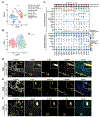The Human and Mouse Enteric Nervous System at Single-Cell Resolution
- PMID: 32888429
- PMCID: PMC8358727
- DOI: 10.1016/j.cell.2020.08.003
The Human and Mouse Enteric Nervous System at Single-Cell Resolution
Abstract
The enteric nervous system (ENS) coordinates diverse functions in the intestine but has eluded comprehensive molecular characterization because of the rarity and diversity of cells. Here we develop two methods to profile the ENS of adult mice and humans at single-cell resolution: RAISIN RNA-seq for profiling intact nuclei with ribosome-bound mRNA and MIRACL-seq for label-free enrichment of rare cell types by droplet-based profiling. The 1,187,535 nuclei in our mouse atlas include 5,068 neurons from the ileum and colon, revealing extraordinary neuron diversity. We highlight circadian expression changes in enteric neurons, show that disease-related genes are dysregulated with aging, and identify differences between the ileum and proximal/distal colon. In humans, we profile 436,202 nuclei, recovering 1,445 neurons, and identify conserved and species-specific transcriptional programs and putative neuro-epithelial, neuro-stromal, and neuro-immune interactions. The human ENS expresses risk genes for neuropathic, inflammatory, and extra-intestinal diseases, suggesting neuronal contributions to disease.
Keywords: ENS; GWAS; aging; circadian; colon; enteric nervous system; enteric neuron; ileum; neuro-immune; single cell.
Copyright © 2020 Elsevier Inc. All rights reserved.
Conflict of interest statement
Declaration of Interests A.R. is a co-founder and equity holder of Celsius Therapeutics, equity holder of Immunitas, and, until August, 2020, an SAB member of ThermoFisher Scientific, Syros Pharmaceuticals, Neogene Therapeutics, and Asimov. A.R. is an employee of Genentech Inc. R.J.X. is a co-founder and equity holder of Celsius Therapeutics and Jnana Therapeutics. E.D. is an employee of Bristol-Myers Squibb. E.D., C.S., G.E., O.R.R., R.X., and A.R. are co-inventors on PCT/US2019/055894, which includes the methods of this manuscript.
Figures







Comment in
-
The enteric nervous system: the hub in a star network.Nat Rev Gastroenterol Hepatol. 2020 Dec;17(12):717-718. doi: 10.1038/s41575-020-00377-2. Nat Rev Gastroenterol Hepatol. 2020. PMID: 33087897 No abstract available.
References
-
- Benjamini Y, and Hochberg Y (1995). Controlling the False Discovery Rate: A Practical and Powerful Approach to Multiple Testing. J. R. Stat. Soc. Series B Stat. Methodol. 57, 289–300.
-
- Bernstein N, Fong N, Lam I, Roy M, Hendrickson DG, and Kelley DR (2019). Solo: doublet identification via semi-supervised deep learning. - PubMed
Publication types
MeSH terms
Substances
Grants and funding
LinkOut - more resources
Full Text Sources
Other Literature Sources
Molecular Biology Databases

